Have you heard, “what gets measured gets managed?”
The famous quote by Peter Drucker accurately describes the approach of many organizations. Successful organizations measure success by embedding metrics throughout the organization.
During a time when there is no shortage of metrics tracked, how do you eliminate some of the noise and focus on the metrics that matter the most?
To be able to quickly look at your organization’s vital signs, it’s important to distinguish between what is a KPI and what is simply a metric.
In This Article
- What Is a KPI?
- KPI Meaning vs. Metrics Meaning
- Why Are KPIs Important?
- Types of KPIs
- How to Develop KPIs
- KPI Examples by Industry
- Tracking Your KPIs
- How AchieveIt Can Help
- Ready to Improve Your Plan Execution?
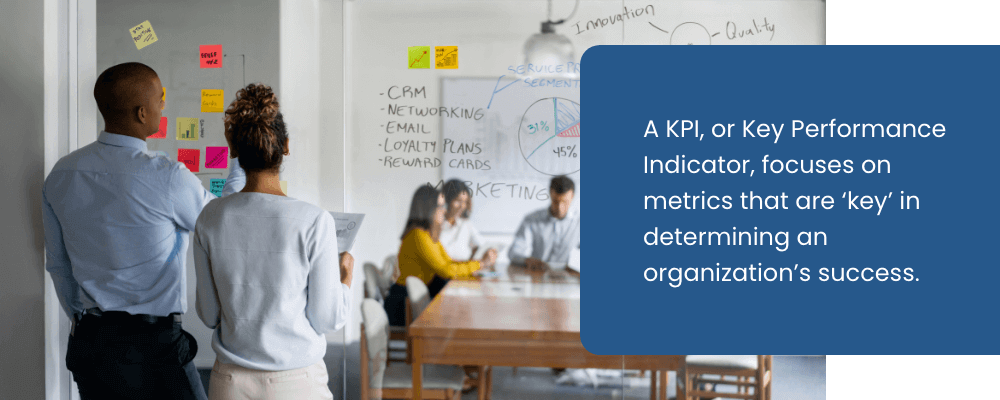
What Is a KPI?
A key performance indicator focuses on metrics that are ‘key’ in determining an organization’s success. More specifically, a KPI defines how an organization is performing across core business objectives. KPIs are a focused way to quantitatively monitor how well an organization achieves key goals.
Identify the critical metrics most aligned with your higher-level organizational objectives. These are likely the KPIs.
Here’s a list of healthcare-industry-specific KPIs you can use as a reference:
- Average length of stay
- Cost per discharge
- Expenses per physician FTE
- Growth rate on equity
- Inventory turnover
4. Education
These are education-industry-specific KPIs you can use as a reference:
- Average daily attendance
- Cost per graduate
- Expenditures per student
- Graduate degrees in high-demand fields
- Institutional debt per student
![]()
Tracking Your KPIs
Once your metrics and KPIs are selected, having a proper mechanism in place to track them will be crucial.
In addition to the status of the KPI, it’s critical to understand how it’s trending. KPIs rarely improve on their own. Also, layer in what initiatives have been completed and will be completed toward improving the KPI.
Successful organizations pair the quantitative elements of KPIs with qualitative information. They combine the “what” with the “why.” The “why” provides the context on the trending of a KPI.
Having a tool and process that easily enables this will make your progress updates informative and actionable, improving the likelihood that you will reach your goals.
How AchieveIt Can Help
AchieveIt is the platform large organizations use to get their most significant, essential initiatives out of the boardroom and into reality. Too many great ideas never quite make it across the finish line because there’s no real way to keep everyone on course and keep everything on track. What does it take to actually guide these initiatives all the way through to completion? You’ve got to:
- Get everything in view: See what’s happening with every initiative, at every level, from the enterprise to the individual, in real-time with a KPI dashboard.
- Get everyone engaged: An easy-to-use platform that connects your organization from the executive leadership to the project teams, keeping everyone accountable and on the same page.
- Get every possible advantage: Benefit from the premier platform and draw on the experience and best practices of our execution experts.
That’s why everyone from global corporations to regional healthcare systems and federal agencies has turned to AchieveIt for their Integrated Plan Management. Let’s actually do this.
Ready to Improve Your Plan Execution?
Organizations of all types leverage AchieveIt to connect, manage and execute their most important initiatives. Replace manual processes and siloed systems with interconnected plans in a single, automated platform.
Ready to improve your plan execution?
Organizations of all types leverage AchieveIt to manage, execute, and connect their most important initiatives. Replace manual processes & siloed systems with interconnected plans in a single, automated platform.
Here’s a list of healthcare-industry-specific KPIs you can use as a reference:
- Average length of stay
- Cost per discharge
- Expenses per physician FTE
- Growth rate on equity
- Inventory turnover
4. Education
These are education-industry-specific KPIs you can use as a reference:
- Average daily attendance
- Cost per graduate
- Expenditures per student
- Graduate degrees in high-demand fields
- Institutional debt per student
![]()
Tracking Your KPIs
Once your metrics and KPIs are selected, having a proper mechanism in place to track them will be crucial.
In addition to the status of the KPI, it’s critical to understand how it’s trending. KPIs rarely improve on their own. Also, layer in what initiatives have been completed and will be completed toward improving the KPI.
Successful organizations pair the quantitative elements of KPIs with qualitative information. They combine the “what” with the “why.” The “why” provides the context on the trending of a KPI.
Having a tool and process that easily enables this will make your progress updates informative and actionable, improving the likelihood that you will reach your goals.
How AchieveIt Can Help
AchieveIt is the platform large organizations use to get their most significant, essential initiatives out of the boardroom and into reality. Too many great ideas never quite make it across the finish line because there’s no real way to keep everyone on course and keep everything on track. What does it take to actually guide these initiatives all the way through to completion? You’ve got to:
- Get everything in view: See what’s happening with every initiative, at every level, from the enterprise to the individual, in real-time with a KPI dashboard.
- Get everyone engaged: An easy-to-use platform that connects your organization from the executive leadership to the project teams, keeping everyone accountable and on the same page.
- Get every possible advantage: Benefit from the premier platform and draw on the experience and best practices of our execution experts.
That’s why everyone from global corporations to regional healthcare systems and federal agencies has turned to AchieveIt for their Integrated Plan Management. Let’s actually do this.
Ready to Improve Your Plan Execution?
Organizations of all types leverage AchieveIt to connect, manage and execute their most important initiatives. Replace manual processes and siloed systems with interconnected plans in a single, automated platform.
Just like metrics, not all KPIs are created equal. To set a good KPI, it needs to have the three following characteristics:
- Quantitative: All KPIs are metrics, which by definition, are quantitative. This gives you a way to measure success. The KPI either needs to be increased, decreased or maintained.
- Well-Defined:Specificity creates clarity. The more defined your KPI is the clearer the picture of success.
- Aligned: Your KPI needs to be aligned to a critical goal or objective in the business that is mission-critical for organizational success.
Goal-setting from the ground up is a more focused and technical procedure. Luckily, you can develop KPIs in seven simple steps:
- Determine key strategic objectives: KPIs must align team actions with the business’s larger goal, which means you must determine your primary strategic objectives.
- Describe the intended results: After determining your key strategic objectives, define what success looks like for your business.
- Understand alternative performance measures: Ideally, all KPIs can track numerical results, such as dollar revenue or survey results. But how can you measure a KPI that can’t be assessed this way? A correlational model with some research may provide an answer.
- Select KPIs for each objective: Now, determine which measurements to utilize. When picking whatever metric to utilize, keep the various types of KPIs and their intended functions in mind.
- Define composite indices as needed: These indices combine numerous KPIs to measure how they impact one another. When it comes to gauging abstract things like brand loyalty and mood, composite indices may be quite valuable.
- Set targets and thresholds: Determine how you’ll interpret the outcomes of these measures by establishing targets and thresholds. Without these thresholds, your indications become more of a metric than a KPI.
- Define and document selected KPIs: Defining and recording your performance measurements is critical before moving from KPI planning to execution. This process includes explicitly explaining the standard you’ve selected to utilize, as well as the designed outcomes to assess, how you gather data and how frequently you’ll evaluate these metrics.
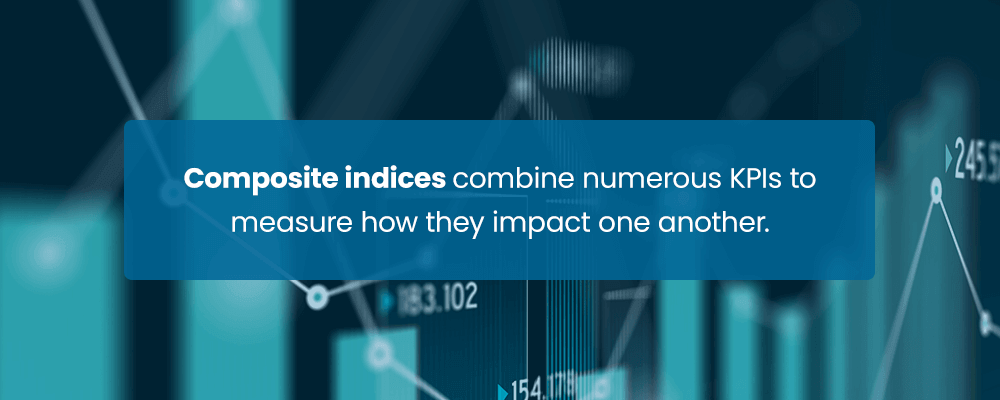
KPI Examples by Industry
Key performance indicators, emphasizing the “key,” will vary across organizations and industries. There’s an enormous amount of KPIs per industry, and you surely don’t have to implement each and every KPI available. The main thing to remember is to know your strategic goals, what you want to achieve, how you want to achieve them and the industry you’re in and your organization.
Here’s a collection of four industry-specific KPIs that serve as a great starting point for managing your organization’s strategies:
1. Finance
These are some finance-industry-specific KPIs you can use as a reference:
- Accounting costs
- Cash conversion cycle
- Earnings per share
- Gross profit margin
- Invoicing processing costs
2. Government
Consider using these government-industry-specific KPIs as a reference:
- Amount of new retail square footage
- Cost per park safety enforcement action on parkland
- Number of patrol hours in neighborhoods
- Park acres per capita
- Voter satisfaction with process
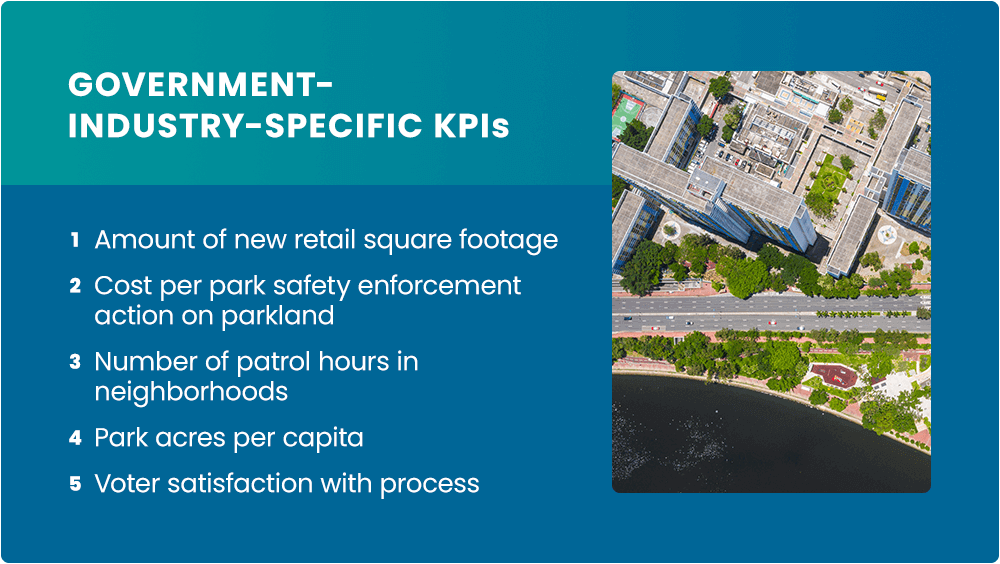
3. Healthcare
Here’s a list of healthcare-industry-specific KPIs you can use as a reference:
- Average length of stay
- Cost per discharge
- Expenses per physician FTE
- Growth rate on equity
- Inventory turnover
4. Education
These are education-industry-specific KPIs you can use as a reference:
- Average daily attendance
- Cost per graduate
- Expenditures per student
- Graduate degrees in high-demand fields
- Institutional debt per student
![]()
Tracking Your KPIs
Once your metrics and KPIs are selected, having a proper mechanism in place to track them will be crucial.
In addition to the status of the KPI, it’s critical to understand how it’s trending. KPIs rarely improve on their own. Also, layer in what initiatives have been completed and will be completed toward improving the KPI.
Successful organizations pair the quantitative elements of KPIs with qualitative information. They combine the “what” with the “why.” The “why” provides the context on the trending of a KPI.
Having a tool and process that easily enables this will make your progress updates informative and actionable, improving the likelihood that you will reach your goals.
How AchieveIt Can Help
AchieveIt is the platform large organizations use to get their most significant, essential initiatives out of the boardroom and into reality. Too many great ideas never quite make it across the finish line because there’s no real way to keep everyone on course and keep everything on track. What does it take to actually guide these initiatives all the way through to completion? You’ve got to:
- Get everything in view: See what’s happening with every initiative, at every level, from the enterprise to the individual, in real-time with a KPI dashboard.
- Get everyone engaged: An easy-to-use platform that connects your organization from the executive leadership to the project teams, keeping everyone accountable and on the same page.
- Get every possible advantage: Benefit from the premier platform and draw on the experience and best practices of our execution experts.
That’s why everyone from global corporations to regional healthcare systems and federal agencies has turned to AchieveIt for their Integrated Plan Management. Let’s actually do this.
Ready to Improve Your Plan Execution?
Organizations of all types leverage AchieveIt to connect, manage and execute their most important initiatives. Replace manual processes and siloed systems with interconnected plans in a single, automated platform.

KPI Meaning vs. Metrics Meaning
Metrics are quantifiable measures established to index progress and identify an organization’s performance.
KPIs are a subset of metrics that underscore the success of a business and highlight some of the most essential measures tracked.
Both metrics and KPIs are important and have their respective purpose. KPIs place an emphasis on what are the most critical metrics.
In short, all KPIs are metrics, but not all metrics are KPIs.
Consider a list of 100 different metrics tracked across your entire organization. Only 20 of them can be discussed at the next board meeting to give board members the best idea of how the business is performing. In most cases, those 20 metrics will be the key performance indicators.
Why Are KPIs Important?
KPIs are more than statistics and metrics — they help you analyze the performance and health of your business so you can make critical changes in your performance and achieve your strategic plans and objectives. By using KPIs, you can set goals, design a strategy to achieve those goals and assess your performance along the way.
There are additional reasons why businesses need KPIs:
- KPIs strengthen morale: The culture of a business is critical to its performance. Tracking KPIs can help recognize employees’ efforts and ensure their sense of accountability and responsibility. People who feel accountable for KPIs are more inclined to push themselves and gain pleasure from a well-done job.
- KPIs support objectives: KPIs are critical to business goals because they keep them at the forefront of decision-making. KPIs also guarantee that performance is monitored in relation to the bigger picture of the business. This means all effort is done with intention and for the correct reason.
- KPIs foster personal growth: Learning from successes and mistakes becomes a continuous effort. Stemming from higher morale, KPIs allow employees to assess and respond to their performance, increasing the likelihood they achieve their goals and learn how to do so in the future. This sense of constant progress enables people to do considerably more than they may expect, which is critical for job satisfaction and personal growth.
- KPIs aid performance management: KPIs make performance management easier by letting everyone see what they’re doing and what others are doing. Transparency ensures every employee works in the same direction, simplifying communication. To promote accountability, track your business’s KPIs in an open and transparent manner.
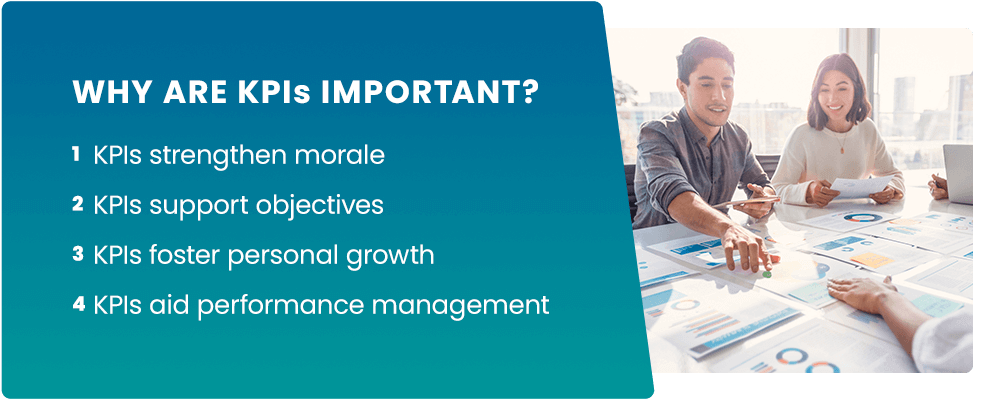
Types of KPIs
Understanding the different types of KPIs is critical for obtaining a holistic view of a business’s history, present and future. Each type of KPI provides useful information that can guide strategic decisions in business development.
Directional
Directional KPIs assess specific patterns inside a business. For example, this indicator can track the amount of time technicians spend on-site addressing and debugging difficulties. Most businesses would want to reduce their average time on site because it indicates a speedier, more effective service. Broad directional indicators can assess your business’s position in relation to competitors in your sector.
Actionable
Actionable KPIs assess and reflect a business’s willingness and ability to adopt business improvements. Actionable indicators evaluate how successfully a business can implement these desired changes within given timeframes. These changes might occur through company culture or corporate operations.
Financial
As the name suggests, financial KPIs measure economic stability, growth and business viability. For example, net profit, gross profit margins, aging accounts receivable and asset ratios are some of the most frequent financial KPIs. Financial indicators give simple insight into a company’s financial health, but they must be combined with the other KPI categories to create a full picture.
Leading
Leading KPIs can assist in identifying long-term trends and possibly forecast the effectiveness of your business operations in the future. For example, a business launching a brand new product or service. Forecasting these indicators might help you make better-informed decisions about prospective market trends or client needs. However, leading KPIs aren’t sufficient indications of success in and of themselves.
Lagging
Lagging indicators monitor outcomes after an action has occurred to assess its success or failure. They’re frequently used to assess previous performance or the impact of a business action. Businesses might use lagging KPIs to assess if their business decisions achieved the desired outcome.
Like leading KPIs, lagging KPIs aren’t as valuable on their own as they are when utilized in historical comparisons, such as month-over-month or quarter-over-quarter performance. Another concern with this type of KPI is they present a historical perspective, and it’s frequently too late to compensate for deficits.
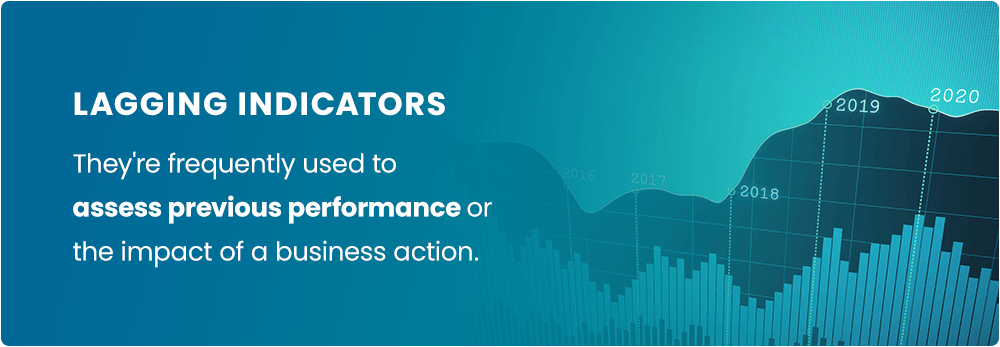
Quantitative
Quantitative indicators are the most straightforward type of KPI as they measure and present only direct numerical values, from percentages to rating scales. There are two types of quantitative indicators — continuous and discrete.
Continuous quantitative indicators can measure any value, including decimals, throughout a range, such as the miles traveled for a mobile service. Discrete quantitative indicators can measure whole numbers, like the number of resolved tickets, customer acquisitions or complaints for call centers and help desks.
Qualitative
In contrast with quantitative indicators, qualitative indicators can’t be measured by numbers. Qualitative KPIs are provided as feelings or opinions rather than numbers, a characteristic of a process or business decision.
For example, an employee satisfaction survey is a popular qualitative indicator. While part of the survey data is quantitative, the measurements themselves depend on a person’s opinion. Qualitative indicators are primarily concerned with feelings or experiences and the intangible worth we place on them.
Input
Input KPIs calculate the resources required for a business process or project to deliver the desired result, such as monetary funds or additional employees. Input indicators track resource efficiency in large projects with many moving pieces, but they’re also beneficial in smaller projects.
Output
Output KPIs consider the success or failure of your company operations — for example, the number of products or services produced through a specific process. Revenue growth and new client acquisition are additional indicators of your company’s performance.
Process
Process KPIs assess the performance of a process and support any necessary modifications. Process indicators describe the efficiency and effectiveness of a business’s processes.
For example, support teams may use customer support tickets as a process KPI. All process metrics that give information on the customer support process include tickets opened, resolved and the average resolve times. In this case, the data can provide essential insights into the business’s current processes that can result in necessary changes in the support process.
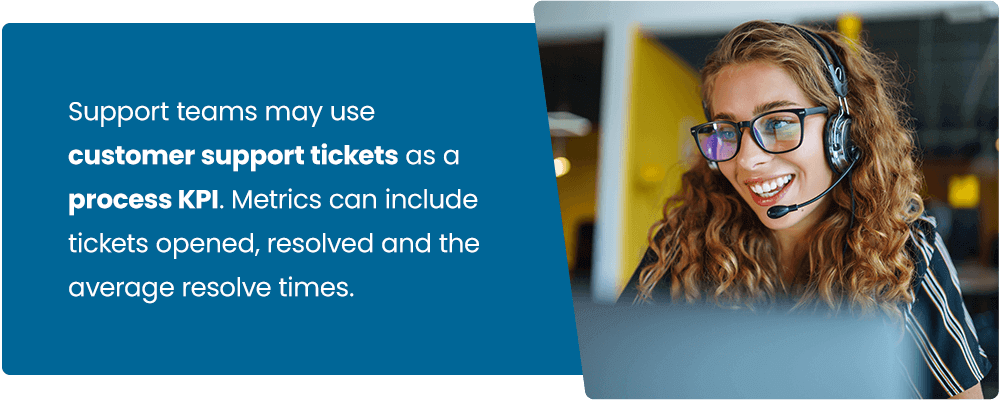
Practical
Practical KPIs consider existing corporate procedures and investigate the consequences of such processes on the business. Practical KPIs also typically observe and provide feedback on these processes. As a result, many practical indications may be exclusive to your business or work procedures.
How to Develop KPIs
According to Tim Clairmont in Forbes’ article “What Are Your KPIs, And Why Do They Matter?“, setting just a few simple KPIs is an excellent way to create a common goal for your company. It will also keep employees from guessing and making assumptions about what’s really important.
Just like metrics, not all KPIs are created equal. To set a good KPI, it needs to have the three following characteristics:
- Quantitative: All KPIs are metrics, which by definition, are quantitative. This gives you a way to measure success. The KPI either needs to be increased, decreased or maintained.
- Well-Defined:Specificity creates clarity. The more defined your KPI is the clearer the picture of success.
- Aligned: Your KPI needs to be aligned to a critical goal or objective in the business that is mission-critical for organizational success.
Goal-setting from the ground up is a more focused and technical procedure. Luckily, you can develop KPIs in seven simple steps:
- Determine key strategic objectives: KPIs must align team actions with the business’s larger goal, which means you must determine your primary strategic objectives.
- Describe the intended results: After determining your key strategic objectives, define what success looks like for your business.
- Understand alternative performance measures: Ideally, all KPIs can track numerical results, such as dollar revenue or survey results. But how can you measure a KPI that can’t be assessed this way? A correlational model with some research may provide an answer.
- Select KPIs for each objective: Now, determine which measurements to utilize. When picking whatever metric to utilize, keep the various types of KPIs and their intended functions in mind.
- Define composite indices as needed: These indices combine numerous KPIs to measure how they impact one another. When it comes to gauging abstract things like brand loyalty and mood, composite indices may be quite valuable.
- Set targets and thresholds: Determine how you’ll interpret the outcomes of these measures by establishing targets and thresholds. Without these thresholds, your indications become more of a metric than a KPI.
- Define and document selected KPIs: Defining and recording your performance measurements is critical before moving from KPI planning to execution. This process includes explicitly explaining the standard you’ve selected to utilize, as well as the designed outcomes to assess, how you gather data and how frequently you’ll evaluate these metrics.

KPI Examples by Industry
Key performance indicators, emphasizing the “key,” will vary across organizations and industries. There’s an enormous amount of KPIs per industry, and you surely don’t have to implement each and every KPI available. The main thing to remember is to know your strategic goals, what you want to achieve, how you want to achieve them and the industry you’re in and your organization.
Here’s a collection of four industry-specific KPIs that serve as a great starting point for managing your organization’s strategies:
1. Finance
These are some finance-industry-specific KPIs you can use as a reference:
- Accounting costs
- Cash conversion cycle
- Earnings per share
- Gross profit margin
- Invoicing processing costs
2. Government
Consider using these government-industry-specific KPIs as a reference:
- Amount of new retail square footage
- Cost per park safety enforcement action on parkland
- Number of patrol hours in neighborhoods
- Park acres per capita
- Voter satisfaction with process

3. Healthcare
Here’s a list of healthcare-industry-specific KPIs you can use as a reference:
- Average length of stay
- Cost per discharge
- Expenses per physician FTE
- Growth rate on equity
- Inventory turnover
4. Education
These are education-industry-specific KPIs you can use as a reference:
- Average daily attendance
- Cost per graduate
- Expenditures per student
- Graduate degrees in high-demand fields
- Institutional debt per student
![]()
Tracking Your KPIs
Once your metrics and KPIs are selected, having a proper mechanism in place to track them will be crucial.
In addition to the status of the KPI, it’s critical to understand how it’s trending. KPIs rarely improve on their own. Also, layer in what initiatives have been completed and will be completed toward improving the KPI.
Successful organizations pair the quantitative elements of KPIs with qualitative information. They combine the “what” with the “why.” The “why” provides the context on the trending of a KPI.
Having a tool and process that easily enables this will make your progress updates informative and actionable, improving the likelihood that you will reach your goals.
How AchieveIt Can Help
AchieveIt is the platform large organizations use to get their most significant, essential initiatives out of the boardroom and into reality. Too many great ideas never quite make it across the finish line because there’s no real way to keep everyone on course and keep everything on track. What does it take to actually guide these initiatives all the way through to completion? You’ve got to:
- Get everything in view: See what’s happening with every initiative, at every level, from the enterprise to the individual, in real-time with a KPI dashboard.
- Get everyone engaged: An easy-to-use platform that connects your organization from the executive leadership to the project teams, keeping everyone accountable and on the same page.
- Get every possible advantage: Benefit from the premier platform and draw on the experience and best practices of our execution experts.
That’s why everyone from global corporations to regional healthcare systems and federal agencies has turned to AchieveIt for their Integrated Plan Management. Let’s actually do this.
Ready to Improve Your Plan Execution?
Organizations of all types leverage AchieveIt to connect, manage and execute their most important initiatives. Replace manual processes and siloed systems with interconnected plans in a single, automated platform.



